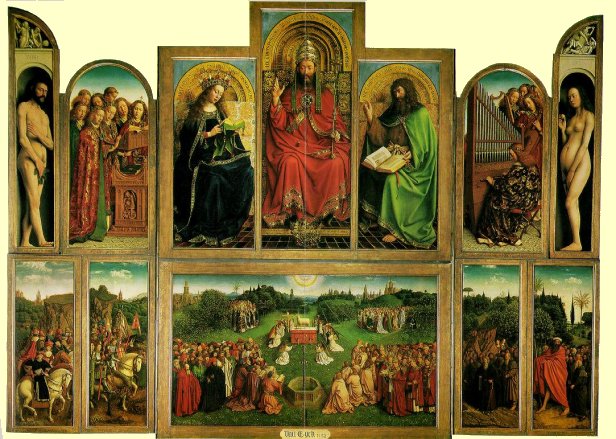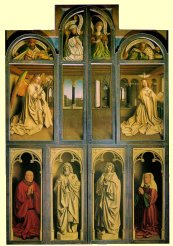

The Ghent Altarpiece
One of the most celebrated paintings of any school or period, The Ghent Altarpiece has always been the core of Jan Van Eyck’s resounding reputation. Albrecht Dürer went to see the altarpiece in 1521 and his verdict that it was "a stupendous painting", has been echoed by artists and critics through the centuries. The altarpiece, a polyptych, has had a dramatic history and has been fortunate to survive, relatively intact, to the present day. In 1566 it narrowly escaped destruction in an outburst of Calvinist iconoclasm when it was hidden in the cathedral tower. The Adam and Eve panels were removed in 1781 because Emperor Joseph II was offended by their nakedness, the French looted other panels in 1794, and still others were sold by the church administrators in 1816. A fire in the cathedral in 1822 did some damage to the panels that remained there. The entire altarpiece was not reassembled until 1920. In 1934 the Just Judges panel (bottom left) was stolen and has never been recovered. The panel now on view is a copy made in 1943-4; the features of one of the figures were altered to resemble those of King Leopold II of Belgium. |
 Altar Panels Closed |
This painting, perhaps Van Eyck’s most famous, is thought to have been begun by Jan Van Eyck’s brother Hubert, of whom little is known; however the painting was completed by Jan Van Eyck in 1432. The Ghent Altarpiece was painted for a church in Flanders, and shows the pious donor and his wife in prayer at the sides. It centres on a large symbolic image - that of the Holy Trinity in the fresco, and on the altar the mystic vision of the Adoration of the Lamb, the lamb of course, symbolizing Christ. The composition is mainly based on a passage in the Revelations of St. John (vii. 9), "And I beheld... a great multitude, which no man could number, of all nations and kindred and people and tongues which stood before the throne and before the lamb ...", a text that is related by the Church to the Feast of All Saints, to which there are further allusions in the painting. Above, we see God the Father, enthroned in splendour like a Pope, between the Holy Virgin and St. John the Baptist, who first called Jesus the Lamb of God. The altar, with its many images, could be shown open, which happened on feast-days, when its glowing colours would be revealed, of shut (on week days) when it presented a more sober appearance. Here the artist represented St. John the Baptist and St. John the Evangelist as statues. To understand the way in which Northern art developed, we must appreciate the infinite care and patience of Van Eyck. The Southern artists of his generation, the Florentine masters of Brunelleschi’s circle, had developed a method by which nature could be represented in a picture with almost scientific accuracy. They built up the human body through their knowledge of anatomy and of the laws of foreshortening. Van Eyck took the opposite way. He achieved the illusion of nature by patiently adding detail upon detail till his while picture became like a mirror of what he saw. This difference between Northern and Italian art remained important for many years. It is a fair guess to sat that any work which excels in the representation of the beautiful surface of things, of flowers, jewels or fabric, will be by a Northern artist, most probably by an artist from the Netherlands; while a painting with bold outlines, clear perspective and a sure mastery of the beautiful human body will be Italian. |
|